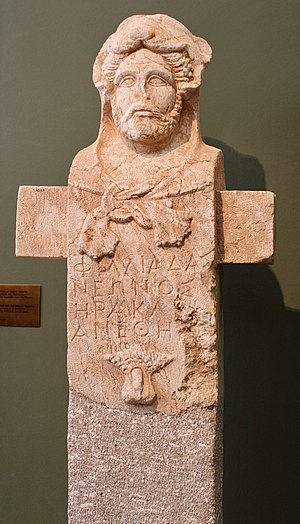Hermeracles: Difference between revisions
ἔνδον γὰρ ἁνὴρ ἄρτι τυγχάνει, κάρα στάζων ἱδρῶτι καὶ χέρας ξιφοκτόνους → yes, the man is now inside, his face and hands that have slaughtered with the sword dripping with sweat
mNo edit summary |
m (Text replacement - "(?s)(==Wikipedia EN==)(\n)(.*$)" to "{{wkpen |wketx=$3 }}") |
||
| Line 9: | Line 9: | ||
|georg=Hermērāclēs, is, m. ([[Ἑρμηρακλῆς]]), [[Merkur]] u. Herkules [[auf]] einem Postamente [[stehend]], Akk. Plur. [[Hermeracles]], Cic. ad Att. 1, 10, 3. | |georg=Hermērāclēs, is, m. ([[Ἑρμηρακλῆς]]), [[Merkur]] u. Herkules [[auf]] einem Postamente [[stehend]], Akk. Plur. [[Hermeracles]], Cic. ad Att. 1, 10, 3. | ||
}} | }} | ||
= | {{wkpen | ||
A [[herma]] (Ancient Greek: [[ἑρμῆς]], pl. ἑρμαῖ hermai), commonly [[herm]] in English, is a sculpture with a head and perhaps a torso above a plain, usually squared lower section, on which male genitals may also be carved at the appropriate height. Hermae were so called either because the head of Hermes was most common or from their etymological connection with the Greek word ἕρματα (blocks of stone), which originally had no reference to Hermes at all. The form originated in ancient Greece, and was adopted by the Romans, and revived at the Renaissance in the form of term figures and atlantes. | |wketx=A [[herma]] (Ancient Greek: [[ἑρμῆς]], pl. ἑρμαῖ hermai), commonly [[herm]] in English, is a sculpture with a head and perhaps a torso above a plain, usually squared lower section, on which male genitals may also be carved at the appropriate height. Hermae were so called either because the head of Hermes was most common or from their etymological connection with the Greek word ἕρματα (blocks of stone), which originally had no reference to Hermes at all. The form originated in ancient Greece, and was adopted by the Romans, and revived at the Renaissance in the form of term figures and atlantes. | ||
}} | |||
Latest revision as of 12:48, 24 October 2022
Latin > English (Lewis & Short)
Hermēracles: is, m., = Ἑρμῆς-Ἡρακλῆς,
I a double bust of Mercury and Hercules, Cic. Att. 1, 10, 3.
Latin > French (Gaffiot 2016)
Hermērāclēs, is, m. (Ἑρμηρακλῆς), buste représentant à la fois Mercure et Hercule : Cic. Att. 1, 10, 3.
Latin > German (Georges)
Hermērāclēs, is, m. (Ἑρμηρακλῆς), Merkur u. Herkules auf einem Postamente stehend, Akk. Plur. Hermeracles, Cic. ad Att. 1, 10, 3.
Wikipedia EN
A herma (Ancient Greek: ἑρμῆς, pl. ἑρμαῖ hermai), commonly herm in English, is a sculpture with a head and perhaps a torso above a plain, usually squared lower section, on which male genitals may also be carved at the appropriate height. Hermae were so called either because the head of Hermes was most common or from their etymological connection with the Greek word ἕρματα (blocks of stone), which originally had no reference to Hermes at all. The form originated in ancient Greece, and was adopted by the Romans, and revived at the Renaissance in the form of term figures and atlantes.

